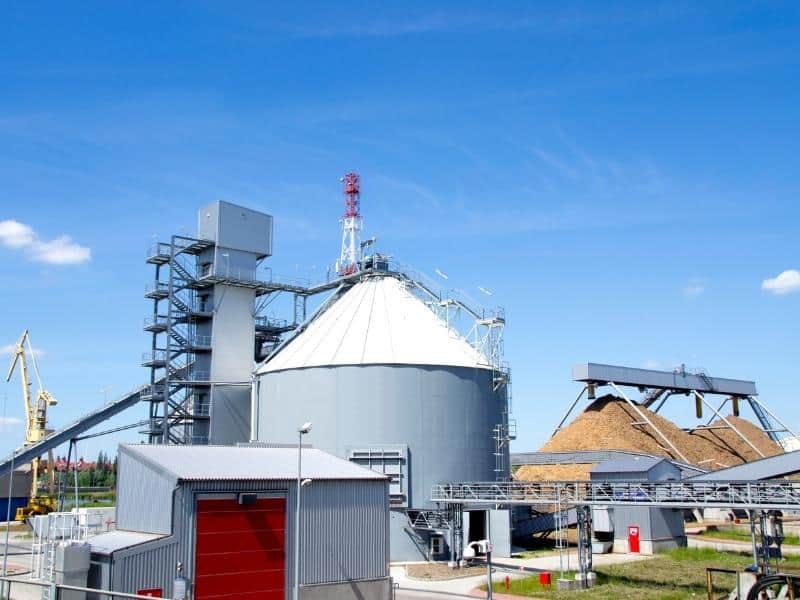Humans have transformed biomass into energy since we learned to use fire for light and heat. In the contemporary era, biomass power plants play an increasingly important role in energy production.
Biomass power plants transform biomass (organic material) into energy as heat, electricity, and liquid and gas fuels. Biomass power plants produce renewable energy from biomass through direct combustion, pyrolysis, gasification, chemical conversion, or microbial decomposition.
In this article, we will consider the following aspects of biomass power plants:
- the processes for converting biomass into energy,
- the types of organic materials used as biomass,
- the methods for managing emissions from biomass power generation,
- the energy production efficiency of biomass power plants
- the use of biomass fuels in liquid fossil fuels.
Biomass power plants have several advantages over conventional fossil fuels, and they are, crucially, a renewable means of generating energy. Let’s take a closer look at how biomass power plants work.

What Are Biomass Power Plants?
Biomass power plants are industrial facilities that convert organic matter into usable energy. These energy generation facilities are composed of combusting units, boilers, turbines or engines (prime movers), power generators, and smokestacks.
Biomass power plants a variety of processes to convert the energy bound up in biomass feedstocks:
- Direct combustion – biomass is burnt to produce heat,
- Microbial conversion – anaerobic bacteria digest and ferment biomass to produce gas and alcohol fuels,
- Pyrolysis – biomass is subjected to heat in the absence of oxygen to produce gas, liquid, and solid fuels,
- Gasification – biomass is subjected to heat and controlled amounts of oxygen and steam to produce gas and liquid fuels,
- Chemical conversion – organic fats and oils are transformed into methyl esters for biodiesel fuel production.
Wood and wood-derived products are the primary sources of biomass for energy production. Other common types of organic material used as fuel in biomass power plants are:
- agricultural plant and animal by-products,
- organic material in municipal waste,
- human and animal manure.
How Do Biomass Power Plants Generate Energy?
Biomass power plants use a range of processes to convert the photosynthetic energy bound up in organic materials into a usable form.
Direct combustion, pyrolysis, gasification, microbial conversion, and chemical conversion are the most commonly-used processes for biomass-to-energy conversion.
Direct Combustion
Direct combustion is the most common process employed to convert biomass into energy. This thermochemical process is relatively straightforward.
Biomass fuel is combusted in a furnace or boiler at between 800F and 1000F, producing heat and high-pressure steam. This steam drives turbines that generate electricity, and in some cases, it is used directly for manufacturing and heating.
Pyrolysis
Pyrolysis is a more complex thermochemical process that converts biomass to an energy source by rapidly subjecting it to high temperatures (800F to 900F) in closed, pressurized vessels referred to as gasifiers.
The pyrolysis process uses little or no oxygen. It produces gas and liquid fuels like diesel fuel, charcoal, bio-oil, hydrogen, and methane.
Gasification
Gasification is also a thermochemical process. However, unlike pyrolysis, gasification heats biomass to higher temperatures (1400F and 1700F), and oxygen and steam are injected into the gasifier (individually or in combination).
The gasification process produces syngas, which is used as fuel in diesel engines, heating systems, and electricity-generating gas turbines.
Chemical Conversion
Chemical conversion is used specifically for converting energy stored in animal fats and vegetable oils. This process involves a chemical reaction called transesterification, which combines organic fats and oils with methanol to produce fatty acid methyl esters.
These fatty acid esters are organic compounds used in bio-diesel production.
Microbial Conversion
Microbial conversion entails the anaerobic digestion and fermentation of biomass by microorganisms to produce gas and liquid fuels.
The process involves four functional groups of bacteria and archaea called guilds. These microbial guilds convert organic material from agricultural, municipal landfills, and sewage wastes into ethanol and renewable natural gas (bio-methane).
What Organic Materials Are Used As Biomass?
Biomass power plants use a wide range of organic materials as biomass feedstock, including wood, agricultural crops and residues, food processing by-products, organic waste in municipal landfills, and human and animal manures.
Wood Biomass
As noted earlier, wood and wood-derived by-products are the primary fuel sources used for biomass energy generation. In the US, for instance, wood accounted for 46% of the biomass fuel supply in 2020.
Raw lumber and wood chips, sawdust, and waste from paper mills are the most common forms of wood-based biomass.
Agricultural Biomass
Plant-based agricultural products and residues are also major sources of biomass fuel. Food processing by-products and crops like sugarcane, soybean, and corn are used widely as fuel sources for biomass power plants.
Animal manure is another agricultural by-product used as biomass to produce power.
Landfill And Sewage Biomass
Biomass power plants use organic matter from municipal landfill waste to generate power. This biogenic organic material includes garden waste, paper, wool, and cotton. Some biomass power plants even use human manure from municipal sewage systems to generate energy.
Procurement And Management Of Biomass Fuels
Having reliable access to the appropriate quality and quantity of organic material is vital for biomass power plants to produce energy effectively and efficiently.
Supplies of organic material can be unpredictable. Considerable planning and effort are required to ensure that a biomass power plant has a consistent and adequate supply of high-quality biomass.
The transportation, storage, and preparation of organic material is another critical aspect of biomass power plant operations and management.
Enormous quantities of organic matter are required to fuel biomass power plants. Therefore, these facilities require large-scale infrastructure and careful management to store the biomass in good condition.
Certain types of organic materials are better suited for conversion in specific types of biomass power generation.
For example, dry material like wood is ideally suited for direct combustion, while wet material like manure and certain food manufacturing wastes are better sources of biomass for microbial conversion.
Do Biomass Power Plants Release Emissions?
The conversion of biomass into energy releases gas and particulate emissions. Biomass power plants use a range of emission control measures to prevent or reduce the release of chemicals and solid materials that could be harmful to human health and the natural environment.
The types of particulates in biomass power plant emissions depend on the kind of biomass being used as a fuel source.
Wood Biomass Emissions
Burning wood biomass for energy generation emits carbon monoxide, which is an odorless, tasteless, and colorless gas that can be toxic to humans and animal life.
Wood-fueled biomass power plants also emit particulate matter. This particulate is composed of substances such as carbon, heavy metals, sulfates, nitrates, and ammonium, and can contaminate soils and ground-water.
Landfill Waste Biomass Emissions
The organic matter in landfill waste is contaminated with toxic synthetic chemicals and heavy metals like cadmium and lead.
Waste-to-energy biomass power plants emit these toxic substances as gases and solid particulates during the power generation process posing a potential danger to humans and the environment if not removed prior to conversion.
Managing Biomass Emissions
Biomass power plants deploy a range of devices to control emissions from the energy generation process. These emission control devices include:
- filters capture particulate as it is emitted from biomass power plant smokestacks,
- scrubbers spray smokestack emissions with a liquid solution that neutralizes acids contained in the emission steam,
- electrostatic precipitators use electrical charges to precipitate emission particulates before they leave the smokestack and enter the surrounding atmosphere.
Advantages And Disadvantages of Biomass Power Plants?
Biomass power plants have significant advantages. They produce renewable energy that is also dispatchable, which means that it can be stored, distributed, and consumed as and when needed.
The main disadvantages of biomass power plants relate to their emissions, and the potential of biomass crop production to displace food crop production.
Advantages Of Biomass Power Plants
The first major advantage is that biomass power plants produce renewable energy that is less harmful to the environment than conventional fuels.
Oil and natural gas are finite natural resources, unlike agricultural crops such as corn and soybeans, which can be continually replenished.
Waste-to-energy power plants municipal landfill and sewage wastes and agricultural and food processing by-products also contribute towards the health of the natural environment by turning these potentially polluting waste materials into usable energy.
Another important advantage of biomass power plants is that they produce what is referred to as dispatchable energy.
This means that biomass energy or fuel can be stored and distributed in a controlled manner to meet specific energy requirements at specific times. The dispatchability of biomass is comparable to that of fossil fuels.
Disadvantages Of Biomass Power Plants
One of the disadvantages of biomass power plants relates to their potential negative environmental impacts.
The emissions from biomass energy generation can potentially pollute the air, groundwater, rivers, streams, and lakes. Some of the agricultural crops used for biomass energy such as sugar cane and oil palm are also farmed in ways that often have negative impacts on local ecosystems.
Another significant disadvantage of biomass power generation is that is can potentially undermine food security.
In some countries, large expanses of agricultural land have been converted to biomass crop production, diverting land, as well as water, labor and other resources that could be used to produce food for the local population.
How Efficient Are Biomass Power Plants?
The efficiency of biomass power generation differs considerably depending on multiple factors, including the type and quality of biomass fuel, the type of conversion process, and the type of power plant.
In general, the energy conversion efficiency of biomass power plants ranges from approximately 20% to 85%.
Direct combustion biomass power plants have an energy conversion efficiency of roughly 20%. Biomass power plants that produce electricity in addition to heat (from direct combustion) have a conversion efficiency that can be as high as 80%.
Biomass power plants that use pyrolysis are more efficient than direct combustion power plants because pyrolysis is a more refined and controlled conversion process, and it uses energy-dense organic materials for biomass fuel.
One study found that the pyrolysis of chicken manure and rice had a conversion efficiency of 84%, while the pyrolysis of rice husks had a conversion efficiency of 89%.
Biomass power plants that use anaerobic digestion can also be highly efficient at converting organic material into dispatchable energy. The energy conversion efficiency of anaerobic digestion power plants is about 75%.
By comparison, the maximum energy conversion efficiency of coal-fired power plants is roughly 45%.
This means that biomass power plants are not only more environmentally sustainable than coal-fired power plants, but in most cases, biomass power plants are also considerably more efficient at generating energy.
What Is The Role Of Liquid Biomass Fuels?
Liquid biomass fuels like ethanol and bio-diesel are used widely in transportation. Bio-diesel is a common additive in petroleum diesel, and virtually all petroleum fuel sold in the US is blended with ethanol.
Biomass power plants mainly produce ethanol from agricultural crops that are high in sugars and starches, such as barley, corn, sugar cane, and sugar beets. Ethanol is also produced from agricultural crop residues and forestry by-products.
These feedstocks are usually converted to ethanol through the microbial process of fermentation.
Bio-diesel is made from biomass that is high in oils and fats. Biomass power plants convert energy bound up in oil and fat-rich biomass into bio-diesel through transesterification.
Bio-diesel is most commonly used as an additive petroleum diesel, and is added at a ratio of 2%, 5%, or 20%.
Ethanol and ethanol-blended liquid fuels have a higher-octane rating than pure petroleum. However, ethanol evaporates into the atmosphere more quickly than petroleum, potentially contributing to harmful air pollution.
Petroleum-ethanol fuel blends require additional processing to mitigate the additional emissions resulting from ethanol’s high rate of evaporation.
The combustion of bio-diesel releases fewer harmful emissions than diesel derived exclusively from fossil fuels.
Compared with conventional diesel, bio-diesel emits more nitrogen oxide. However, bio-diesel is less environmentally harmful overall, because it emits less carbon monoxide, sulfur oxide, and less partially-combusted hydrocarbons and other particulate matter than conventional diesel.
What Is The Future Of Biomass Power Plants?
Looking ahead, biomass power plants have a legitimate role in the future of environmentally-responsible, renewable energy generation.
Though biomass power plants are not pollution-free, they use renewable feedstocks and convert waste to usable energy. Emissions from biomass power plants are also generally less environmentally harmful than conventional, fossil fuel-based power plants.
Biomass power plants can therefore make a vital contribution to the transition towards sustainable energy production.
References:
- https://www.energy.gov/search/site?keywords=biomass+power
- https://www.wbdg.org/resources/biomass-electricity-generation
- https://www.eia.gov/energyexplained/biomass/
- https://www.eia.gov/todayinenergy/detail.php?id=15451
- https://www.sciencedirect.com/topics/chemistry/direct-combustion
- https://www.ncbi.nlm.nih.gov/pmc/articles/PMC7198183/
- https://www.eia.gov/energyexplained/biomass/biomass-and-the-environment.php
- https://www.pfpi.net/wp-content/uploads/2011/04/PFPI-biomass-carbon-accounting-overview_April.pdf
- https://www.nap.edu/read/10378/chapter/3
- https://www.sciencedirect.com/science/article/pii/S1877705817326188
- https://www.valorgas.soton.ac.uk/Pub_docs/JyU%20SS%202011/CB%204.pdf
- https://pubs.acs.org/doi/10.1021/acs.energyfuels.9b01264
- https://www.researchgate.net/publication/282824169_Thermal_efficiency_of_coal-fired_power_plants_From_theoretical_to_practical_assessments
- https://www.eia.gov/energyexplained/biofuels/biodiesel.php
- https://www.eia.gov/energyexplained/biofuels/ethanol.php



